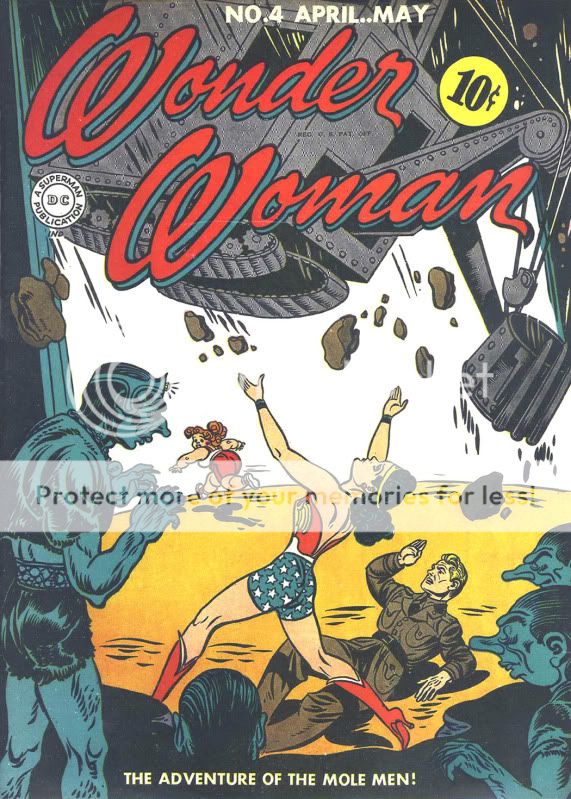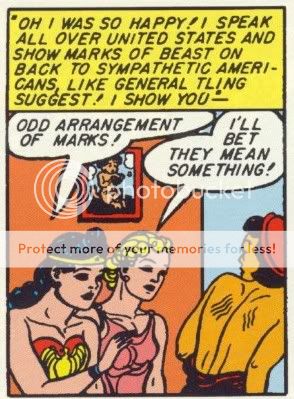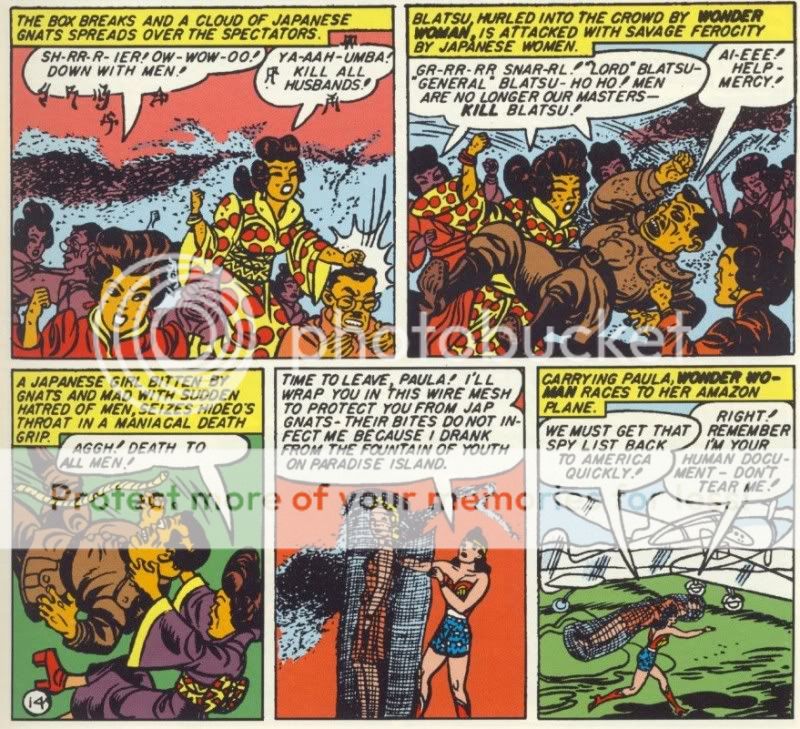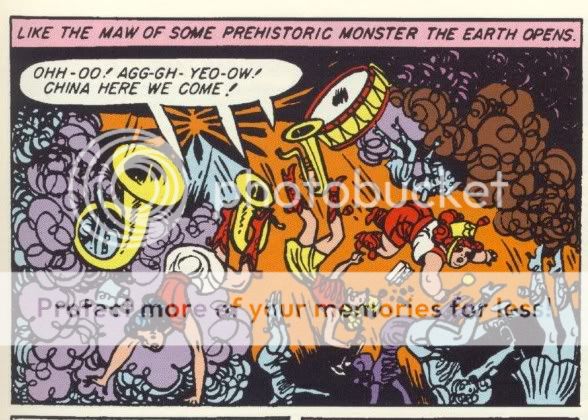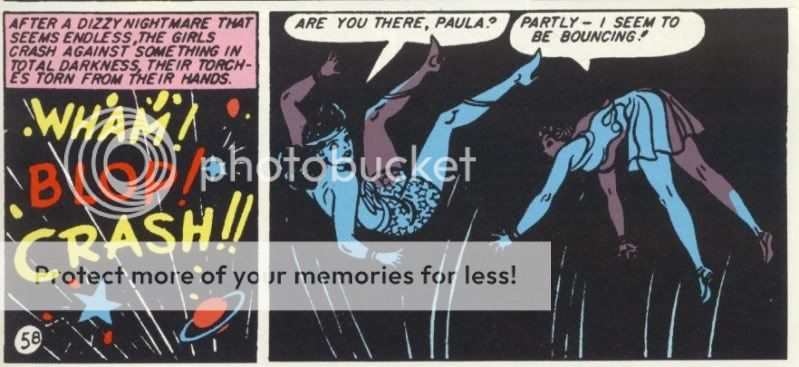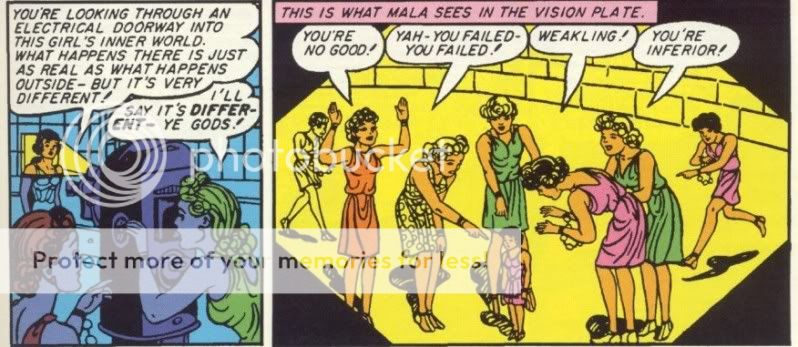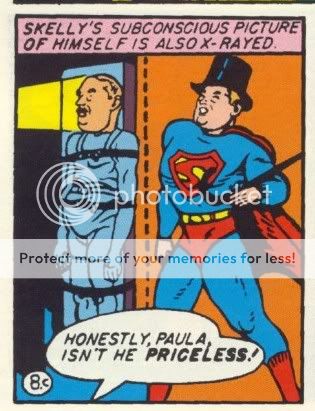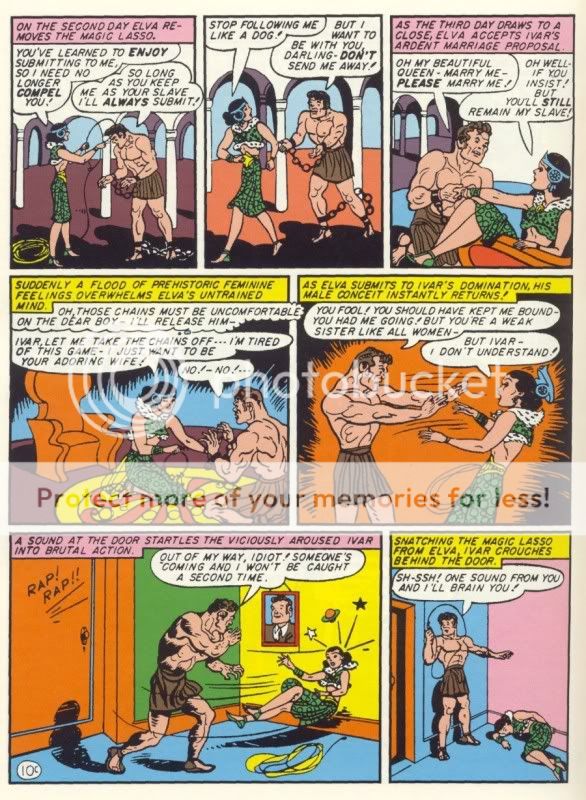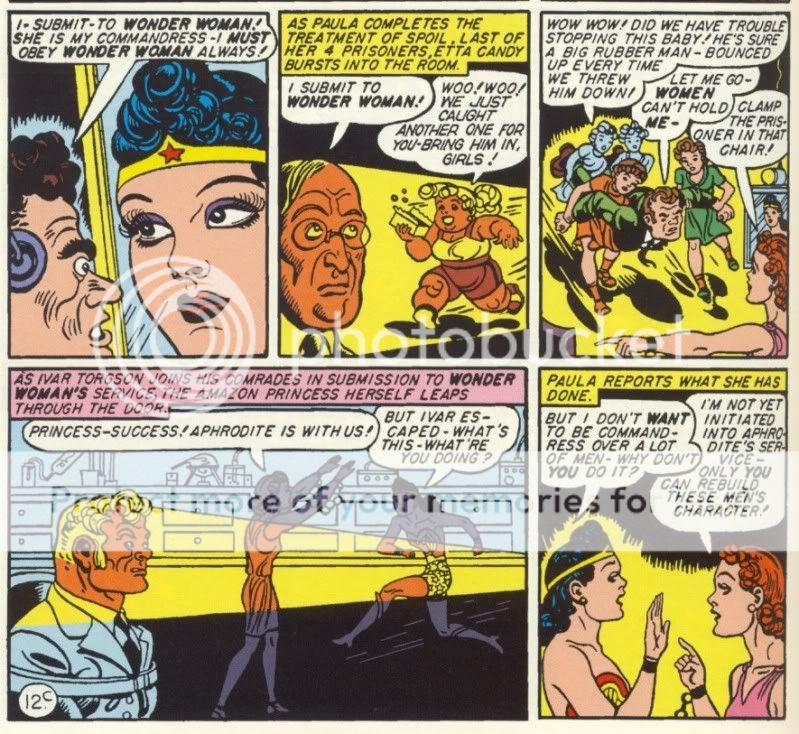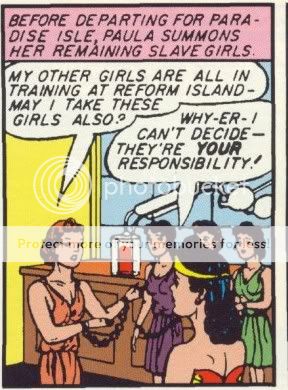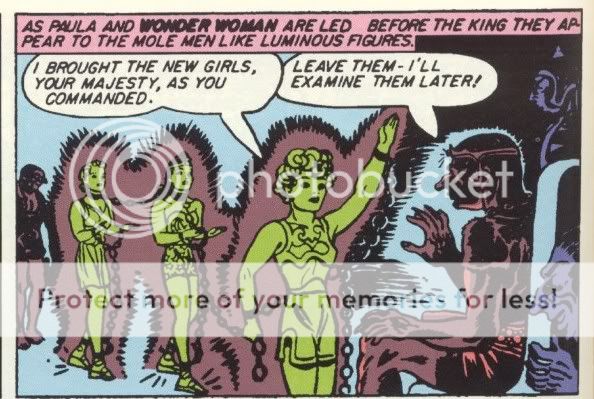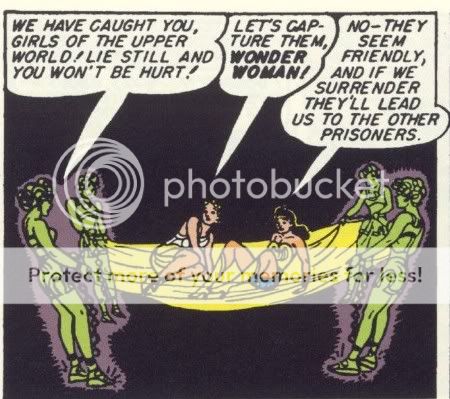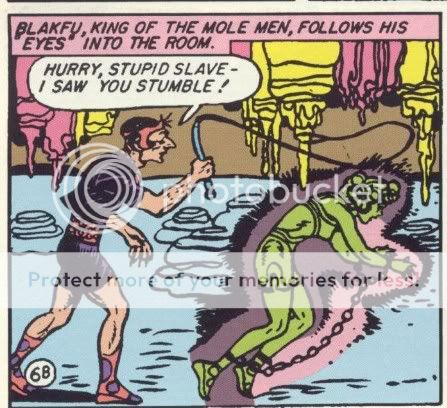Monthly Archives: April 2009
Kyoko Okazaki’s Mothbitten Wardrobe
Some unsorted thoughts on Helter Skelter, based on Noah’s post and its comments:
- Noah notes the the absense of fashion for a comic about the fashion world. The art lacks the patchwork quilt of pattern common in girls’ and women’s comics; the clothes are pretty bland, too. I suppose it’s a statement. Okazaki was a fashion illustrator, so she chose not to show that off. And some of the most fashion-conscious artists at the time were men drawing women for men, like Kousuke Fujishima. Ririko’s like, screw all you guys, I’m naked.
- Another current: the body as fashion canvas, as this article on plastic surgery in Asia points out. Even the non-surgical version can be seen just walking around Shibuya (or Amerika-mura, as I prefer), with the ganguro girls’ tanning. (Scroll down in Wikipedia to read about “Blacky,” a ganguro girl who became iconic and then quit the lifestyle from public pressure.)
- Japanese fashion made sense to me once someone told me it’s all just uniforms. Everything has its place: white gloves for driving trains, track pants for teaching kids, and punk stylings for the weekend. I always felt like a shabby barbarian until I picked a store and bought some uniforms. They keep the surface placid, everything in its place. Ririko’s place is looking better-than-human, another uniform enabled with surgery. I’m not from LA so I don’t have a nose for who’s had work done. I suspect the unwritten contracts require it in Tokyo.
- In my essay on Dousei Jidai in a recent TCJ, I pointed to Ian Buruma’s Behind the Mask for a nuanced discussion of women’s bodies in Japanese art. When everything has its place, transgression and expression have to take place behind closed doors. That’s why In the Realm of the Senses is a political movie, other than one about sleeping with scissors.
- Until it started to feel like actual research, I pottered around in my bookshelves for some “reception history,” as it’s known. I skimmed through a manga encyclopedia from Helter Skelter back to 1980 or so. Having found dozens of books I never want to read and a couple I absolutely have to (Natsuko’s Sake and Shouta’s Sushi in particular, maybe I’m just hungry), I saw dozens of stories of old-fashioned romance. None other like Okazaki’s whatsoever. And an article noting that Okazaki’s 1989 work Pink was one of the first comics for women to get a crossover audience, garnering a lot of praise from all kinds of readers and critics. So there’s that.
Anyway, I’m off to work in Louisville tonight, which in a couple of weeks will be flooded with millinery.
Bound to Blog: Wonder Woman #4
Not sure anyone but diehards are reading this at this point…but in case you’re new, I’m blogging my way through the entire original Marston/Peter run on Wonder Woman. We’re up to issue 4. And here’s the cover….
I’d sort of hoped to see the last of Baroness Paula Von Gunther last issue when she pulled a Bleak House and got her ugly mug replaced. I’m not that interested in her, and she’s always involved in espionage plots, which aren’t necessarily my favorite Marston efforts. No luck, though; she’s back for this entire issue apparently, being subjected to a series of tests by Aphrodite to prove that she’s sufficiently submissive or dominant or good or some combination of all three. And sure enough, the first story is pretty underwhelming. I mean, oh sure, you’ve got hot Chinese girls showing off their whip scars….
and hot Chinese girls showing off their whip scars
and then there’s the hot Chinese girls showing off their whip scars
And there’s also hot Amazon on Amazon action with some poorly motivated competition involving catching each other with ropes, and then there’s the girls attached to weird rejuvenation machines (Paula invents one, everyone having apparently forgotten that WW invented one in issue #1). Also some really nasty Japanese caricatures. But most of it’s pretty familiar by now, and there aren’t any deer costumes or anything to push it over the edge into utter jaw-dropping WTF absurdity. Except maybe for the Japanese gnats that bite women and cause them to attack men.
That’s pretty crazy. But even there….I don’t know, I was hoping for more than just a couple of panels of murderous women…and kind of hoping to see WW herself flip out. But doesn’t happen; she’s drunk from the fountain of youth on Paradise Island, you see, which apparently gives you immunity to rabid gnats. Those Amazons think of everything.
The next sotry, though, is more like it. Instead of espionage, we’ve got a mysterious race of mole men lurking under Holiday College. Of course, the Mole Men keep herds of chained and semi-willing female slaves tied up in their underground kingdom. Though the mole men are blind from their long time in the dark, they keep track of their slaves by covering them with special paint that emits ultraviolet rays which can penetrate the mole men’s sealed eyelids. Amidst a subterranean performance by the Holiday College band, WW and Paula free the female slaves, and then perform non-consensual surgery on all the mole men, restoring their sight. Now that they’re able to see the beauty that is women, they become all submissive, and beg their former slaves to take command of them. Happy endings all round.
In their own bizarre way, the WW comics are definitely part of a tradition of children’s fantasy literature. Underground kingdoms show up in many classics — Journey to the Center of the Earth obviously, but a a more likely precursor in terms of trippy oddness might be L. Frank Baum’s Dorothy and the Wizard in Oz. (not “of Oz”; this one involves them wandering in the underworld beneath Oz.) In one panel, Paula says as she drops and drops, “this is like a dream of falling,” which seems like it has to be a deliberate nod to Carroll. There are several other similar scenes as well….
I love that drawing, especially; Parker’s scribbly curls of smoke setting off the elegantly controlled lines of the tuba and Peter’s characteristically stiff figure drawing. I like the way the smoke opening up in the off-center middle gives the sense of a great deal of space just out of vision; it’s almost like you’re seeing a small segment of an infinite universe of plummeting co-eds. There’s a touch of Winsor McCay, if McCay were, say, 10 years old. And horny.
Because, and to no surprise, Parker’s evocation of childish scribblies is matched by prepubescent eroticism. Dropping through space, the girls unconsciously assume the position; bent over, butt high, or even just legs pointing straight up, face obscured. The helplessness of falling is definitely fetishized, even more so here:
Cartoony cartoony sound effects give way to bouncing about helplessly in the dark, with Paula unconsciously pointing her posterior towards the camera. (They’re bouncing on a taut fabric held held by numerous women — kind of the adventure version of a sleepover pillow fight.)
I guess one could say that Marston and Peter are perverting the Alice story…but it might be closer to the truth to say that they’re explicating a perversion that was already there. Lewis Carroll had his own sexual interests (though they were probably less kinky than Marston’s) and you don’t have to read “Lost Girls” to pick up tinges of polymorphous pleasures in Alice. Falling into holes, “Eat Me!”, “Drink Me!”, flesh stretching and twisting and elongating…. I know, at least, when I was a kid, I found John Teniel’s illustrations of Alice growing and telescoping to be oddly suggestive. Same with the various weird bodies described in “Dorothy and the Wizard in Oz” — in fact, truth to tell, I don’t remember a ton from that book except the sense of bizarrely sublimated bodies wandering through a subterranean landscape.
There’s at least some literature on the link between the fantasy genre and masochistic fantasy. A bit back I read a 1923 essay by Anna Freud called “Beating Fantasies and Daydreams”; she was talking about a 15-year old girl who had early masturbatory beating fantasies which were elaborated into an extensive fantasy life with a whole cast of characters, a complex history, multiple scenarios that she’d go back into and tweak or revise or rethink. She called the stories “nice stories” because they weren’t explicitly sexual, but she came to see them as springing from that original primal beating fantasy; as being inherently masochistic. (And a quick search of the web reveals that the girl was not in fact an anonymous girl, as she claimed, but rather Anna Freud herself.)
I think masochism generates, and thrives on stories; on pretending or adopting different power relations — let’s pretend you control me, or that you are going to hurt me. Those stories are often as much the object of fetishization as the masochistic acts themselves (which is what I was getting at in this post.). Certainly for Marston’s narratives seem to be both fantasies and fantasies, as it were, and I suspect that this is the reason that WW’s origin story isn’t as elegant a some other heroes, like Superman, Spiderman, Batman, etc. Tom suggests it’s because Marston had trouble imagining powerful women but I think it’s more likely that Marston had a stake in complicated stories — stories particularly with lots of characters, lots of relationships, and lots of power reversals. (And I think the “lots of relationships” part, at least, is actually often typical of genre literature aimed at girls, as opposed to more solitary-hero literature aimed at boys. But I digress….)
You can see some of what I mean when I say “the narrative is a fetish” by looking at how Marston uses it didactically. That is, Marston actually spends a lot of time essentially providing instructions about being a strong/good woman. Women must always trust their strength:
They must have a strong self-image (and you can find out whether they do by using a machine which reveals their subconscious thoughts…because involuntary confession is healthy…and stimulating!)
(This is from the third story, where we also get to see the subconscious image of themselves that men have, incidentally. Here’s one representative example:
Hey! Is that Mort Weisinger?)
Sorry about the detour. Back to instructions for healthy young women: they should carry themselves like queens not slaves.
And they must never, ever abandon the scenario or…disaster!
Similarly, you must never deny responsibility or turn away from authority; woman need to accept their mothering, reforming role even if it means burning their images into the brains of unprepossessing middle-aged idiots
Or even if it means arbitrarily deciding to keep folks in non-consensual slavery
because if you shirk authority, Aphrodite will reprimand you:
(I think I’ve mentioned before how much I like Peter’s use of scale. WW is here drawn way smaller than perspective calls for, which emphasizes her vulnerability and submission. He does that sort of thing all the time.)
The point here is that the instructions are all basically narrative in nature; they’re about telling stories correctly, or participating in role-playing in the correct way. And, of course, these instructions are themselves part of the story; correction and instruction is itself part of masochistic fetishization. This is part of the reason that Marston’s moralizing instructions never feel tacked on or like gratuitous pandering to the condescending uplift view of the role of children’s literature. The instructions for living he provides are integrated, idiosyncratic, and charged; they’re clearly as much the point for him as are the fight scenes, or the bondage scenes.
It’s also why when it’s on, WW has a a fetishistic frisson between form and content which is like little else in comics. I’ve compared the series to Henry Darger before, and I think looking to outsider art makes a lot of sense; there’s an obsessive pleasure in the craft — the storytelling and I think the art as well — which is echoed in the obsessive pleasure in the content in such a way that the two are almost inseparable, reinforcing each other in a kind of cascade.
To go back to the mole man story…details are piled on details in a way that seems almost random and certainly excessive (as fetishes tend to be excessive.) Thus, the mechanics of mole-men/slave relations and interactions are explained in loving and really ridiculous detail: in the deep dark, women’s eyes adjust to the dark quickly, but men’s don’t, and so the men go blind, like the mole men. But the mole men can nonetheless see the slaves, even though mole men eyes are sealed shut from disuse. How can they see the slaves you ask? Well, because they slather the slaves in a special glowing paint which gives off ultra-violet radiation, penetrating the mole-men’s lids and allowing them to whip their slaves. And that’s just the exposition for one page…never mind the static earth electricity or the horrible dancing trap or the escape plot involving the Holiday Girls breaking into song, or…well, you get the idea.
These narrative tergiversations, though, all circle around and lock into Marston’s (and probably Peter’s) obsessions; you can almost hear the series of sighs as they elaborate and close, elaborate and close. The glowing paint, for example, creates the narrative necessity (or excuse) for some of Peter’s most striking visuals; panel after panel of women glowing like beacons in the dark, with Peter picturing their radiance through quick, thick obsessive lines merging into inky cocoons — mysterious and contained, transcendent and controlled, otherworldly in bizarre lurid green and purple. (Again I ask, who did the colors for these books?)
The emphasis on sight, blindness, and invisibility is another Marston obsession, and here you can really see how it locks in with his bondage and masochistic and narrative preoccupations:
Again, that’s such a great drawing by Peter, with those lovely scribbly lines defining the floor and the regimented series of stalactites obtruding into the foreground to give the sense of contained, claustrophobic space, both oppressive and womb-like. On one level, the mole man is the master; he’s whipping her. But on another level, she is the only thing he can see. Her submission and denigration (being slathered in paint (and yes, I’m sure Marston thought that was kinky in itself) so she can be better punished) makes her the center of his vision. He’s blind because he’s a man, and so a fool…but there’s also the sense that he’s blind contractually, as part of the negotiation whereby the top in a B&D relationship pretends to be in control. Not that this is necessarily a metaphor or a coded symbol of any of these things in particular, but rather that all of the tropes — control, blindness, single-focus, debasement, the promise of a fantastic and unduplicatable intimacy, the sense of a shared dark space, the narrative explanation and negotiation — are pleasurable in themselves, and then get combined and recombined in a kind of fractal fetish.
All of which means that Marston’s statements about power always have at least as much to do with rubbing the fetish as they do with actual analysis or advocacy. Thus, when he makes feminist statements — I don’t think they’re totally useless to a feminist cause, but they are compromised, in that the goal of his feminism is always more about the men’s desires than women’s. As a for instance — why *should* Wonder Woman have to take control of the lives of a bunch of middle-aged male idiots? Her tomboyish response of, hey! forget this! I’ve got better things to do! seems entirely reasonable and even admirable, and when Aphrodite scolds her for it, it seems unjust and transparently done on Marston’s behalf. Similarly, at the end of the Mole-Men episode, when the mole men regain their site and beg their former slaves to rule over them, you’d really like the slaves to say, “hell no! fuck off!” Especially since, if the female slaves were actually the ones with the power (as it intimated in various ways) it makes sense that the male slaves will now be, in some sense, the topping bottoms. Having women rule is about allowing the men to become self-actualized — or allowing Marston to get his rocks off.
And yeah, that last panel is Etta Candy so blinded by oral desire and subterranean dimness that she starts sucking on a stick of dynamite. I was sort of hoping she’d get a mole-man of her own, but no such luck. Maybe next issue.
Oh, But It Is, David Alex!
In comments to my Helter Skelter post, David Alex said this:
i found ririko more attractive (both aesthetically and as a fake-personality) at the end than at the beginning of the manga… the eyepatch.
That’s not exactly a request, but I’m practicing how to crop and upload images. So check it out!
Spider-Man 2
I just saw this. It’s really good, I thought; easily the best super-hero movie I’ve seen (and yes, that means it’s better than the Dark Knight.) Tobey Maguire is excellent as Peter; he’s got charming neurosis down cold, and he’s got a nice sense of comic timing too; Peter’s constant litany of hard luck comes across as both funny and touching, and you’d have to be pretty hard-hearted to begrudge him the happy ending (though I do wish MJ had told him off more thoroughly about the “I can’t risk your life” thing. He deserved to be told off for that.)
I mean, it wasn’t perfect or anything. The effects were pretty blah, — the computer generated stuff just doesn’t look all that good, and the blocking tended to be confusing rather than dramatic in the fight scenes. And having Doc Ock keep kidnapping those nearest and dearest to Peter just by accident strained credulity. But overall, it’s amazing how much the story benefited from being a story rather than a serial, so you could do things like, for example, give Doc Ock some sort of coherent personality, and a storyline with a beginning and end, rather than being forced to make him just an evil nutter and keep him around for infinite reboots. Which is to say, with all the flaws, I pretty solidly liked this more than the original comic, which I read not that, that long ago. It seemed like this got at the core of Lee’s concept — the melodrama, the humor, the moral dilemma — a lot more cleanly and subtly than Lee managed to himself. (I know Ditko’s art is really what’s supposed to tip the scales…but as I think I’ve admitted before, his work on Spider-Man never really thrilled me the way it does lots of comics fans.)
Come to think of it, I believe I like the Christopher Reeves movie overall better than the original Siegel/Shuster comic, or even than the Mort Weisinger silver age stuff. And I liked the Adam West Batman movie way, way more than the vast majority of comic-book Batman stories. For what that’s worth.
Updated: Edited to fix Tobey Maguire’s name. He spells it with an “e”? Who knew?
Tai Chi at Dawn
I’m an American living in Montreal. My French is okay but not great. Right now I’m sitting in a Subway and the counter guy is playing a radio that has a very high-energy announcer running off a long spiel in French. He sounds just like any guy who has to keep the airtime hopping between song tracks. Except, emerging out of the murk of his non-English, the phrase “t’ai chi a l’aube” keeps recurring. That means “t’ai chi at dawn.” WTF?
… okay, he’s doing play by play on a game. Presumably one player with a name like “t’ai chi” keeps passing to a player who has a name like “l’aube.” But it’s still kind of fucked up.
Diana Sue
In comments a couple days back I was encouraged to check out Bluefall’s series on Wonder Woman When Wondy Was Awesome. I didn’t read the whole thing, I must admit, but I poked about a bit here and there, and did read through her post on the book League of One, which I read and reviewed earlier myself here.
Bluefall’s certainly an entertaining writer and an attentive reader. She makes a strong (though to me, not convincing) case for League of One being something other than a complete piece of crap. For example, she has a nice point about WW’s attentiveness to relationships:
Diana’s plans, on the other hand, rely entirely on the League’s greatest strength, on her assumption that her friends will look out for each other. She’s able to defeat J’onn and Kyle because they trust her; she gets Clark out of the picture by forcing him to rescue their friends. She’s able to launch the League into space in the first place because she knows they’ll be okay. He plan succeeds because she sees things in terms of relationships and reactions, rather than individual physical traits.
For me, unfortunately, this is largely vitiated by the fact that all the relationships in the book are both unbelievable and vapid; it’s not especially impressive to be able to parse interpersonal dynamics when all your interpersonal dynamics basically consist of bland corporate boy scouts declaring allegiance to one another (except for Batman, who, you know, is dark because he uses reverse psychology.) Not even bluefall’s quixotic insistence on referring to them all by their first names can convince me that these badly painted figurines have any inner lives not imposed by front office dictat. Still, I guess the book should get points for the earnestness with which it attempts to move the corpses about in a lifelike manner.
What I mainly took away from reading these posts is that bluefall really likes Wonder Woman (or “Diana”.) That’s a big part of how she reacts to WW comics, it looks like. That is, she knows she likes WW, and she judges the comics to some extent on how well they live up to her image of what Wonder Woman should be. For instance, in talking about John Byrne’s run, she commented that she liked the way that Byrne made Diana as powerful as she should be relative to other characters in the DC universe.
I think this is maybe part of the reason some of my posts have rubbed some WW fans the wrong way. Because, the thing is, I really couldn’t give a pile of kangaroo-horse poop (to cite a creature indigenous to Paradise Island in Marston’s run) about whether WW is as powerful as she should be, or about whether she’s as noble as she should be, or whether she behaves in character, or out of character, or is depowered and dressed in white, or whatever. I love the original Marston/Peter run, which I think is one of the few truly idiosyncratic works of art to come out of the super-hero genre. And it’s fun to see other creators try (and largely fail) to deal with the bizarre thing Marston and Peter created. But I don’t care if creators get her “right” except insofar as they tell a story that seems worth reading. If you can tell a good story making WW able to push planets around, that’s fine; if you can tell a good story making her only slightly stronger than Etta Candy, that’s fine too (Marston probably did both of those things at some point.) If you want to make her impulsive and eager to hit people and that works, cool; if you want to make her preach peace and love and you can get that to work, more power to you (I suspect Marston did both of those things as well.) I don’t like most of the WW stories I’ve read by folks other than Marston because they’re boring and dumb, not because WW isn’t sufficiently noble or iconic or whatever. In short, I’m not a fan in the usual sense; at least not of the character.
I don’t necessarily have anything against fans…or even against fan fiction, which is where this kind of investment in a character abstracted from a particular story tends to lead. I haven’t read a ton of fan fiction, but there is some of it I like quite a bit. Some of it I really don’t want to look at, but that’s just personal preference, not an aesthetic line in the sand.
Still, I think super-hero comics do run into a problem with the fan-base…that problem being that there isn’t in fact a canon. The WW bluefall likes isn’t the Marston/Peter WW, which is old and embarrassing and weird. It’s not really the Silver Age WW either, which was embarrassing in different ways; nor is it really the modern day WW, who, after all, bluefall tends to judge against an ideal, and often to find wanting (the swimsuit, for example, would be ditched if bluefall had her way.) And I think that’s all fairly typical; the ideal WW that fans enthuse about is…an ideal; it’s not an actual character or version of the character, but rather some platonic vision of the way the character would be if the perfect writer wrote her, or, I guess, if she were real.
The thing is, when you unmoor the character from any actual creative team, you drift into one of two problems. On the one hand, you end up with stories written by folks who don’t care about the character and don’t really have any idea what to do with her…and WW has certainly had that happen to her over the years. On the other hand, though, you can also end up with stories that are just devoted to showing how wonderful the character is…and WW has had her share of those, too. In fact, that seems to be the whole point of “League of One”; it’s aggrandizing fan scruff for WW fans who want to be assured that WW is just the awesomest there is. See, she beats the whole Justice League! And she beats a big bad dragon because she’s so much purer than everyone, even Superman! She’s so good and brave and awesome, just like WW should be! (Bluefall does object slightly because the script intimates that Superman could actually beat WW in a fair fight, which bluefall feels is wrong because, I guess, nobody can beat WW, damn it. But since WW beats Superman by trickery anyway, bluefall is willing to let it pass.)
In short, with no agreed upon canon,there’s a strong tendency for the character to drift towards that bane of fan-fiction, the Mary Sue. Wikipedia has a good definition:
Mary Sue, sometimes shortened simply to Sue, is a pejorative term used to describe a fictional character who plays a major role in the plot and is particularly characterized by overly idealized and hackneyed mannerisms, lacking noteworthy flaws, and primarily functioning as wish-fulfillment fantasies for their authors or readers. Perhaps the single underlying feature of all characters described as “Mary Sues” is that they are too ostentatious for the audience’s taste, or that the author seems to favor the character too highly. The author may seem to push how exceptional and wonderful the “Mary Sue” character is on his or her audience, sometimes leading the audience to dislike or even resent the character fairly quickly; such a character could be described as an “author’s pet”.
Mary Sues are, as I said, usually created by fans…but everyone writing WW is pretty much just a fan at this point, the original creators being long, long gone and their concept in most respects abandoned. In any case, there’s a self-conscious reiteration of, well, wonderfulness in League of One that is extremely tiresome, and which is a consistent though less discussed aspect of super-hero decadence. At its core, League of One isn’t all that different from Marvel Zombies. The second is characterized by desperate desecration, the first by desperate consecration. But both are more interested in the act of burnishing/befouling the icon than they are with telling a story. (Which, come to think of it, is what I said about All Star Superman, now that I think about it. And, of course, I was right then too!)
______________________
Incidentally, this post is part of a series on WW’s post-Marston iterations. The entire series is called Only One Can Wear the Venus Girdle and you can see all the relevant posts here.














